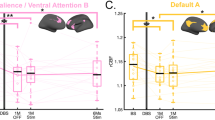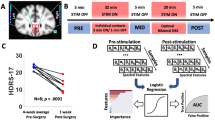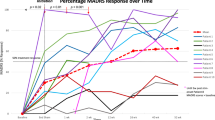Abstract
Target identification and contact selection are known contributors to variability in efficacy across different clinical indications of deep brain stimulation surgery. A retrospective analysis of responders to subcallosal cingulate deep brain stimulation (SCC DBS) for depression demonstrated the common impact of the electrical stimulation on a stereotypic connectome of converging white matter bundles (forceps minor, uncinate fasciculus, cingulum and fronto-striatal fibers). To test the utility of a prospective connectomic approach for SCC DBS surgery, this pilot study used the four-bundle tractography ‘connectome blueprint’ to plan surgical targeting in 11 participants with treatment-resistant depression. Before surgery, targets were selected individually using deterministic tractography. Selection of contacts for chronic stimulation was made by matching the post-operative probabilistic tractography map to the pre-surgical deterministic tractography map for each subject. Intraoperative behavioral responses were used as a secondary verification of location. A probabilistic tract map of all participants demonstrated inclusion of the four bundles as intended, matching the connectome blueprint previously defined. Eight of 11 patients (72.7%) were responders and 5 were remitters after 6 months of open-label stimulation. At one year, 9 of 11 patients (81.8%) were responders, with 6 of them in remission. These results support the utility of a group probabilistic tractography map as a connectome blueprint for individualized, patient-specific, deterministic tractography targeting, confirming retrospective findings previously published. This new method represents a connectomic approach to guide future SCC DBS studies.
This is a preview of subscription content, access via your institution
Access options
Subscribe to this journal
Receive 12 print issues and online access
$259.00 per year
only $21.58 per issue
Buy this article
- Purchase on Springer Link
- Instant access to full article PDF
Prices may be subject to local taxes which are calculated during checkout




Similar content being viewed by others
References
Mayberg HS, Lozano AM, Voon V, McNeely HE, Seminowicz D, Hamani C et al. Deep brain stimulation for treatment-resistant depression. Neuron 2005; 45: 651–660.
Lozano AM, Mayberg HS, Giacobbe P, Hamani C, Craddock RC, Kennedy SH . Subcallosal cingulate gyrus deep brain stimulation for treatment-resistant depression. Biol Psychiatry 2008; 64: 461–467.
Malone DA Jr., Dougherty DD, Rezai AR, Carpenter LL, Friehs GM, Eskandar EN et al. Deep brain stimulation of the ventral capsule/ventral striatum for treatment-resistant depression. Biol psychiatry 2009; 65: 267–275.
Bewernick BH, Hurlemann R, Matusch A, Kayser S, Grubert C, Hadrysiewicz B et al. Nucleus accumbens deep brain stimulation decreases ratings of depression and anxiety in treatment-resistant depression. Biol Psychiatry 2010; 67: 110–116.
Sartorius A, Henn FA . Deep brain stimulation of the lateral habenula in treatment resistant major depression. Med Hypotheses 2007; 69: 1305–1308.
Jimenez F, Velasco F, Salin-Pascual R, Hernandez JA, Velasco M, Criales JL et al. A patient with a resistant major depression disorder treated with deep brain stimulation in the inferior thalamic peduncle. Neurosurgery 2005; 57: 585–593..
Schlaepfer TE, Bewernick BH, Kayser S, Madler B, Coenen VA . Rapid effects of deep brain stimulation for treatment-resistant major depression. Biol Psychiatry 2013; 73: 1204–1212.
Bergfeld IO, Mantione M, Hoogendoorn ML, Ruhe HG, Notten P, van Laarhoven J et al. Deep brain stimulation of the ventral anterior limb of the internal capsule for treatment-resistant depression: a randomized clinical trial. JAMA Psychiatry 2016; 73: 456–464.
Crowell AL, Riva-Posse P, Garlow SJ, Mayberg H . Toward an understanding of the neural circuitry of major depressive disorder through the clinical response to deep brain stimulation of different anatomical targets. Curr Behav Neurosci Rep 2014; 1: 55–63.
Lozano AM, Giacobbe P, Hamani C, Rizvi SJ, Kennedy SH, Kolivakis TT et al. A multicenter pilot study of subcallosal cingulate area deep brain stimulation for treatment-resistant depression. J Neurosurg 2012; 116: 315–322.
Puigdemont D, Perez-Egea R, Portella MJ, Molet J, de Diego-Adelino J, Gironell A et al. Deep brain stimulation of the subcallosal cingulate gyrus: further evidence in treatment-resistant major depression. Int J Neuropsychopharmacol 2012; 15: 121–133.
Merkl A, Schneider GH, Schonecker T, Aust S, Kuhl KP, Kupsch A et al. Antidepressant effects after short-term and chronic stimulation of the subgenual cingulate gyrus in treatment-resistant depression. Exp Neurol 2013; 249: 160–168.
Ramasubbu R, Anderson S, Haffenden A, Chavda S, Kiss ZH . Double-blind optimization of subcallosal cingulate deep brain stimulation for treatment-resistant depression: a pilot study. J Psychiatry Neurosci 2013; 38: 120–160.
Guinjoan SM, Mayberg HS, Costanzo EY, Fahrer RD, Tenca E, Antico J et al. Asymmetrical contribution of brain structures to treatment-resistant depression as illustrated by effects of right subgenual cingulum stimulation. J Neuropsychiatry Clin Neurosci 2010; 22: 265–277.
Holtzheimer PE, Kelley ME, Gross RE, Filkowski MM, Garlow SJ, Barrocas A et al. Subcallosal cingulate deep brain stimulation for treatment-resistant unipolar and bipolar depression. Arch Gen Psychiatry 2012; 69: 150–158.
Dougherty DD, Rezai AR, Carpenter LL, Howland RH, Bhati MT, O'Reardon JP et al. A randomized sham-controlled trial of deep brain stimulation of the ventral capsule/ventral striatum for chronic treatment-resistant depression. Biol Psychiatry 2015; 78: 240–248.
Schlaepfer TE . Deep brain stimulation for major depression—steps on a long and winding road. Biol Psychiatry 2015; 78: 218–219.
Welter ML, Schupbach M, Czernecki V, Karachi C, Fernandez-Vidal S, Golmard JL et al. Optimal target localization for subthalamic stimulation in patients with Parkinson disease. Neurology 2014; 82: 1352–1361.
Eisenstein SA, Koller JM, Black KD, Campbell MC, Lugar HM, Ushe M et al. Functional anatomy of subthalamic nucleus stimulation in Parkinson disease. Ann Neurol 2014; 76: 279–295.
Dombrowski SM, Hilgetag CC, Barbas H . Quantitative architecture distinguishes prefrontal cortical systems in the rhesus monkey. Cereb Cortex 2001; 11: 975–988.
Hamani C, Mayberg H, Snyder B, Giacobbe P, Kennedy S, Lozano AM . Deep brain stimulation of the subcallosal cingulate gyrus for depression: anatomical location of active contacts in clinical responders and a suggested guideline for targeting. J Neurosurg 2009; 111: 1209–1215.
Mayberg HS . Targeted electrode-based modulation of neural circuits for depression. J Clin Invest 2009; 119: 717–725.
Riva-Posse P, Choi KS, Holtzheimer PE, McIntyre CC, Gross RE, Chaturvedi A et al. Defining critical white matter pathways mediating successful subcallosal cingulate deep brain stimulation for treatment-resistant depression. Biol Psychiatry 2014; 76: 963–969.
Henderson JM . "Connectomic surgery": diffusion tensor imaging (DTI) tractography as a targeting modality for surgical modulation of neural networks. Front Integr Neurosci 2012; 6: 15.
Coenen VA, McIntyre CC . Letter to the Editor: correlation of diffusion tensor imaging and intraoperative macrostimulation. J Neurosurg 2015; 123: 291–292.
Hamilton M . A rating scale for depression. J Neurol Neurosurg Psychiatry 1960; 23: 56–62.
First MB, Gibbon M, Spitzer RL, Williams JBW . Structured Clinical Interview for DSM-IV Disorders—Research Version (SCID-II, Version 2.0). New York State Psychiatric Institute: New York, NY, USA, 1994.
American Psychiatric Association. Diagnostic and Statistical Manual of Mental Disorders: DSM-IV-TR, 4th edn. American Psychiatric Press: Washington, DC, USA, 2000.
Sackeim HA . The definition and meaning of treatment-resistant depression. J Clin Psychiatry 2001; 62: 10–17.
Smith SM, Jenkinson M, Woolrich MW, Beckmann CF, Behrens TE, Johansen-Berg H et al. Advances in functional and structural MR image analysis and implementation as FSL. NeuroImage 2004; 23: S208–S219.
Jenkinson M, Beckmann CF, Behrens TE, Woolrich MW, Smith SM . Fsl. NeuroImage 2012; 62: 782–790.
Smith SM . Fast robust automated brain extraction. Hum Brain Map 2002; 17: 143–155.
Jenkinson M, Bannister P, Brady M, Smith S . Improved optimization for the robust and accurate linear registration and motion correction of brain images. NeuroImage 2002; 17: 825–841.
Behrens TE, Woolrich MW, Jenkinson M, Johansen-Berg H, Nunes RG, Clare S et al. Characterization and propagation of uncertainty in diffusion-weighted MR imaging. Magn Reson Med 2003; 50: 1077–1088.
Zhang C, Li Z, Wu Z, Chen J, Wang Z, Peng D et al. A study of N-methyl-d-aspartate receptor gene (GRIN2B) variants as predictors of treatment-resistant major depression. Psychopharmacology 2014; 231: 685–693.
Chaturvedi A, Lujan JL, McIntyre CC . Artificial neural network based characterization of the volume of tissue activated during deep brain stimulation. J Neural Eng 2013; 10: 056023.
Choi KS, Riva-Posse P, Gross RE, Mayberg HS . Mapping the "depression switch" during intraoperative testing of subcallosal cingulate deep brain stimulation. JAMA Neurol 2015; 72: 1252–1260.
McGrath CL, Kelley ME, Dunlop BW, Holtzheimer Iii PE, Craighead WE, Mayberg HS . Pretreatment brain states identify likely nonresponse to standard treatments for depression. Biol Psychiatry 2014; 76: 527–535.
Lehman JF, Greenberg BD, McIntyre CC, Rasmussen SA, Haber SN . Rules ventral prefrontal cortical axons use to reach their targets: implications for diffusion tensor imaging tractography and deep brain stimulation for psychiatric illness. J Neurosci 2011; 31: 10392–10402.
Heilbronner SR, Haber SN . Frontal cortical and subcortical projections provide a basis for segmenting the cingulum bundle: implications for neuroimaging and psychiatric disorders. J Neurosci 2014; 34: 10041–10054.
Setsompop K, Kimmlingen R, Eberlein E, Witzel T, Cohen-Adad J, McNab JA et al. Pushing the limits of in vivo diffusion MRI for the Human Connectome Project. NeuroImage 2013; 80: 220–233.
Smart OL, Tiruvadi VR, Mayberg HS . Multimodal approaches to define network oscillations in depression. Biol Psychiatry 2015; 77: 1061–1070.
Acknowledgements
We acknowledge Mary Kelley, PhD (Rollins School of Public Health, Emory University) for her collaboration and input in data management. We also acknowledge Angela Noecker (Biomedical Engineering, Case Western Reserve University) for assistance in the development of tractography models. We thank the collaboration of the research staff: Sinéad Quinn, Kelsey Hagan, Morgan Woody, Lydia Denison, as well as the patients and their families.
Author contributions
P Riva-Posse and KS Choi contributed equally to the design, data analysis, preparation of the manuscript.
Author information
Authors and Affiliations
Corresponding author
Ethics declarations
Competing interests
PE Holtzheimer reported serving as a paid consultant to St Jude Medical. RE Gross reported receiving grants from Medtronic, Neuropace and MRI Interventions, honoraria from Medtronic Inc and MRI Interventions; and serving as a paid consultant to St Jude Medical, Medtronic, Neuropace, MRI Intervantions, Neuralstem and SanBio. CC McIntyre is a paid consultant for Boston Scientific Neuromodulation, and is a shareholder in the following companies: Surgical Information Sciences; Autonomic Technologies; Cardionomic; Enspire DBS; Neuros Medical. HS Mayberg has a consulting agreement with St Jude Medical, which has licensed her intellectual property to develop SCC DBS for the treatment of severe depression (US 2005/0033379A1). Medtronic and St Jude Medical Corp develop products related to the research described in this article. The terms of these arrangements have been reviewed and approved by Emory University in accordance with their conflict of interest policies. The remaining authors declare no conflict of interest.
Additional information
Disclaimer
Hope for Depression Research Foundation, Dana Foundation, NIH R01MH102238 (PI: Cameron McIntyre). The funding sources had no role in the design and conduct of the study; collection, management, analysis, or interpretation of the data; preparation, review, or approval of the manuscript; and decision to submit the manuscript for publication.
Supplementary Information accompanies the paper on the Molecular Psychiatry website
Supplementary information
Rights and permissions
About this article
Cite this article
Riva-Posse, P., Choi, K., Holtzheimer, P. et al. A connectomic approach for subcallosal cingulate deep brain stimulation surgery: prospective targeting in treatment-resistant depression. Mol Psychiatry 23, 843–849 (2018). https://doi.org/10.1038/mp.2017.59
Received:
Revised:
Accepted:
Published:
Issue Date:
DOI: https://doi.org/10.1038/mp.2017.59
This article is cited by
-
Closing the loop in psychiatric deep brain stimulation: physiology, psychometrics, and plasticity
Neuropsychopharmacology (2024)
-
Cortical signatures of sleep are altered following effective deep brain stimulation for depression
Translational Psychiatry (2024)
-
A large normative connectome for exploring the tractographic correlates of focal brain interventions
Scientific Data (2024)
-
The future of brain circuit-targeted therapeutics
Neuropsychopharmacology (2024)
-
Deep brain stimulation for refractory major depressive disorder: a comprehensive review
Molecular Psychiatry (2024)



